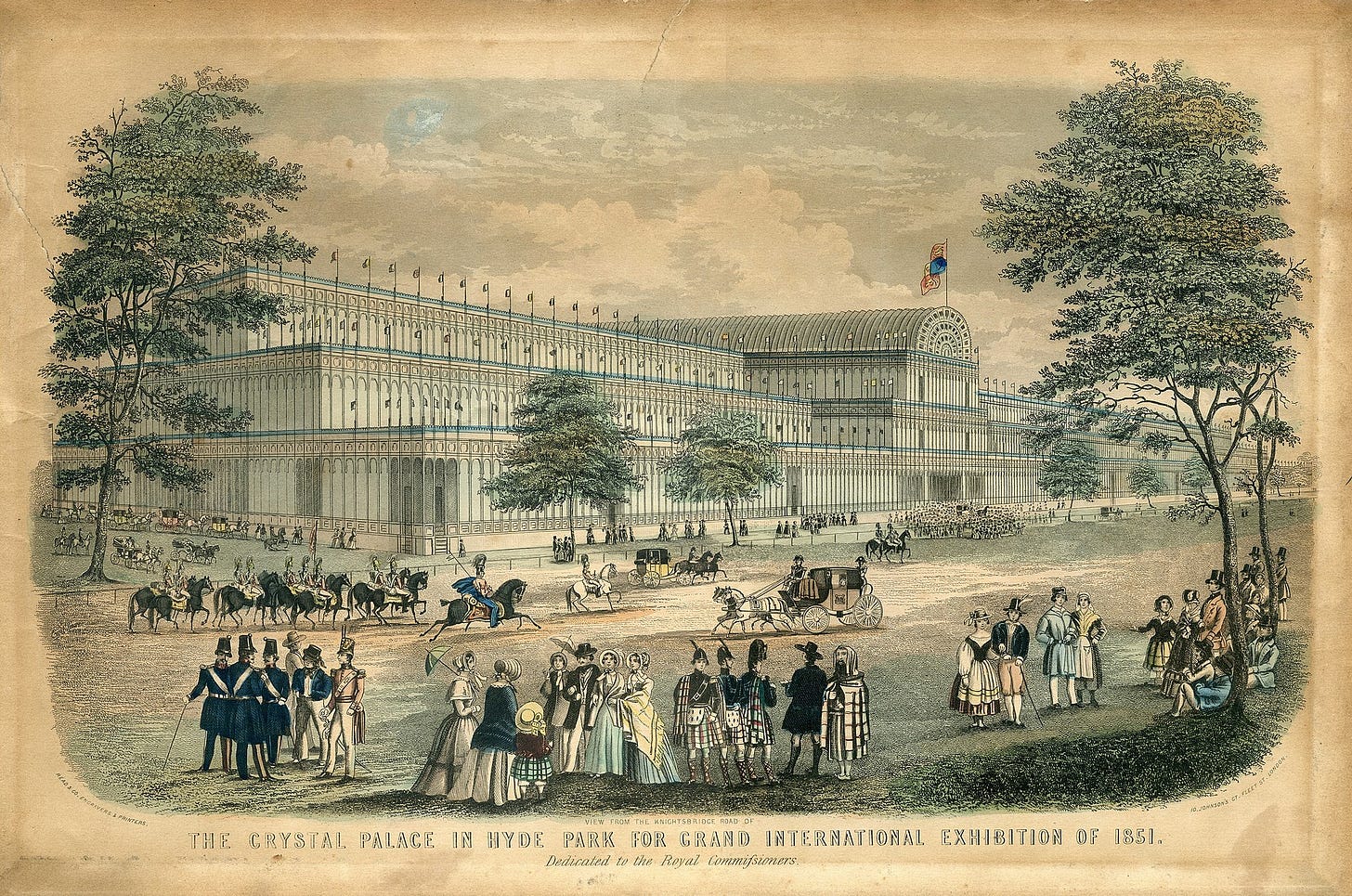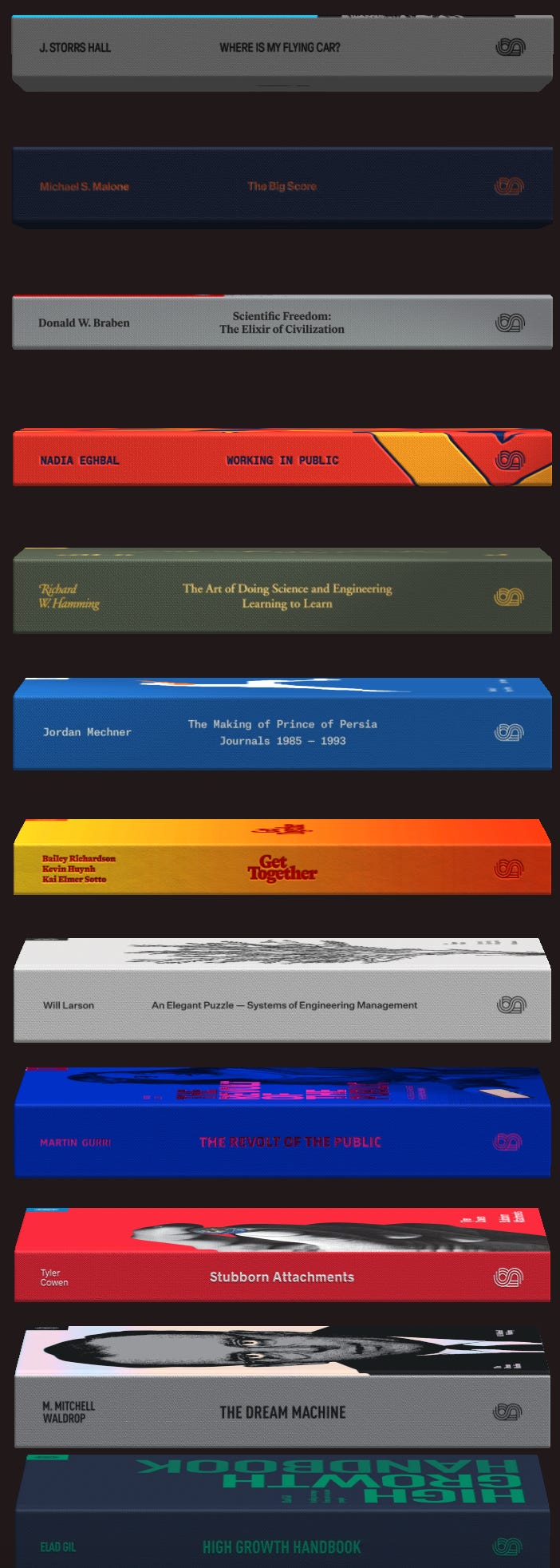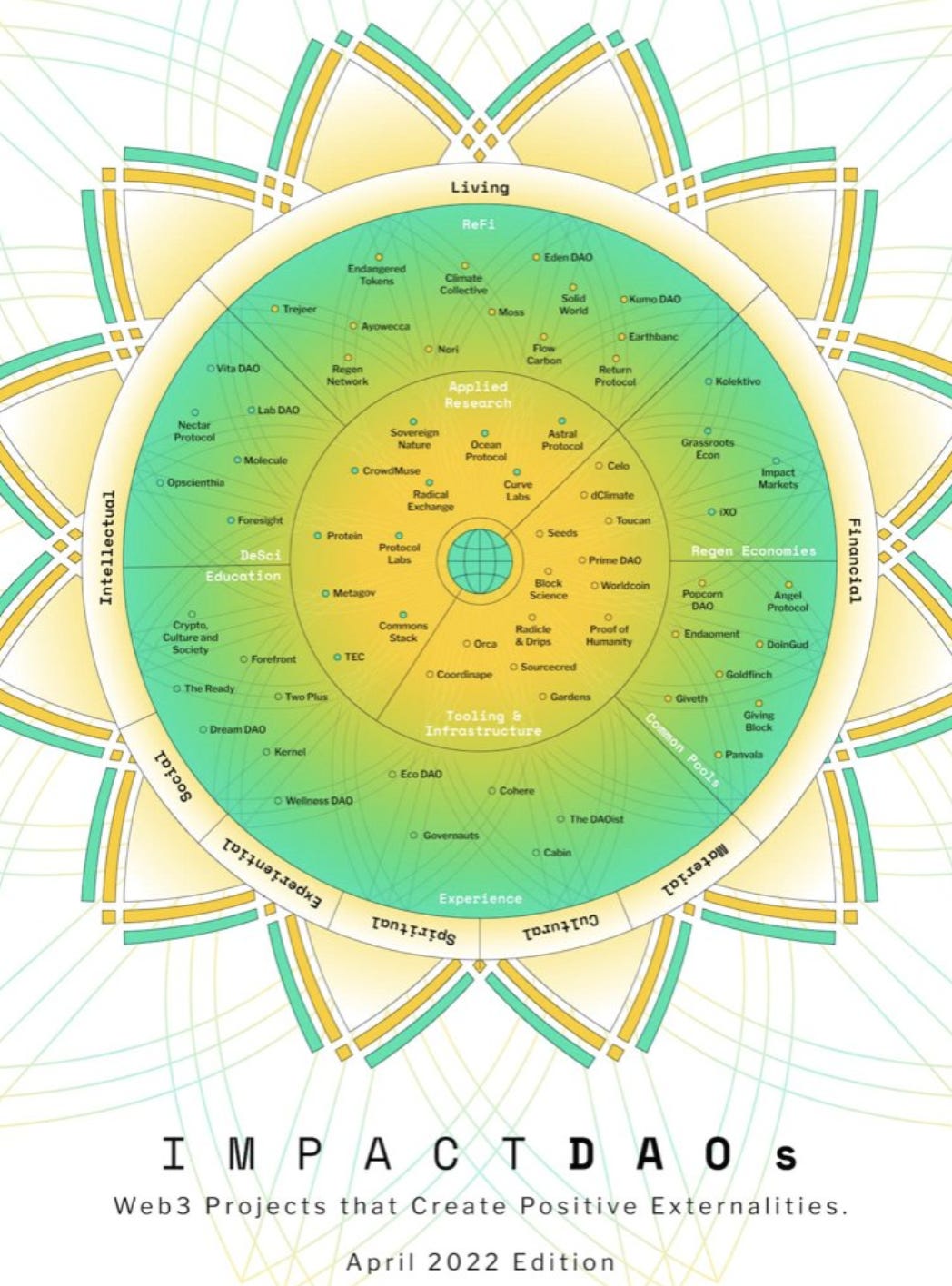
With love to all the intellectual movements depicted below.
You hear the buzz of a thousand conversations as you enter the convention center. The building is one of those weird postmodern complexes that is somehow both ancient Greek and brutalist. It looks as if the architects couldn’t agree on a single style, or even on what the point of this building was. A fitting venue for such an event.
You get your badge from the registration desk. It comes with a bunch of goodies in a tote bag. A pen, shaped like a hammer, with the slogan “IT’S TIME TO BUILD.” A voucher for vegan food at the cafeteria. A QR code to register your attendance on a blockchain. A watch that just tells the current year, with five digits: 02022. A slip of paper that says, “Instead of giving you a cheap keychain or whatever, we have donated part of our convention budget to GiveWell.”
There’s also a map of the convention. At the top it says WELCOME TO THE FIRST IDEA MACHINE FAIR. You look at the layout of the main exhibition hall. You don’t have that much time, so you’ll only visit the stalls you’re most familiar with as a heavy Twitter user:
Rationality
Effective Altruism
Progress Studies
The Sovereign Charter City of Good Governance
some amorphous cluster of booths that is charted as The DAO-verse
Archeofuturism
Metascience.
You look up from the map, past the Art Nouveau / ancient Egyptian / 1960s modernist doors of the main hall. So many brilliant minds are in there, discussing what could be the most influential ideas of the near future. You walk in.
An idea machine, according to Nadia Asparouhova, is a subculture or a community that forms around an ideology in order to achieve some outcome. Idea machines are wider than movements (like YIMBYism), but not as wide as paradigm shifts (like crypto as a whole). But also, no one knows what an idea machine exactly is, or which real-life idea machines exist, or what the boundaries between them are. This convention is meant to clarify all of that.
You’re not sure it’s helping.
You stand in the alley between the Rationality and Effective Altruism stalls, listening to some guy in basic shorts and a gray t-shirt explaining the differences between the two to a few visitors.
“See, rationality is about thinking well. Whereas EA is about optimization to do the most good. The focus is different.”
“But what’s the point of thinking well?” someone asks. “Isn’t it so that you can do good?”
“And how do you optimize for good,” someone else says, “if not by thinking well?”
“I mean, sure, there’s a lot of overlap,” the gray t-shirt guy says. “But they’re distinct communities. You could say that EA was born from combining rationality and the work of a bunch of Oxford philosophers. Rationality didn’t come from Oxford philosophers. See, big difference!”
You turn your attention to the Rationality table. Two nice but slightly awkward guys start giving you books. “Yeah, the best way to engage with rational thinking is reading the main texts,” one of them, a long-haired man wearing a space-themed leotard says as he hands you a nicely bound collection of essays. “Rationality: A-Z by Eliezer Yudkowsky is the main one. But a lot of people, myself included, have been introduced to us by a Harry Potter fanfiction: Harry Potter and the Methods of Rationality. It’s long but really good.” He gives you a custom printed paperback. “This is the first fifth of the story or so. You may also want to read some essays by Scott Alexander.” He gives you another pile of papers. “Oh, we have a bunch of copies of Superintelligence to give out too, if you want to know about AI risk.” He reaches beneath the table and adds a book with a picture of an owl to your pile. “There are more books, but we don’t have that many copies here. We could mail them to you, though. Also check out Less Wrong dot com, there’s a lot of great material there.”
Your pile has become heavy, so you set it down on the table. “That’s, uh, a lot,” you say. “Can’t you give me a five-minute pitch or something?”
The two guys look at each other, unsure what to say. The one who hasn’t spoken yet says, “Well, are you familiar with Bayes’ theorem?”
“Vaguely,” you say.
The guy points behind him, on the mobile partition wall. A neon sign is hung to it:

“I guess that’s the core thing,” the guy says. “Probabilisitic thinking. That, and overcoming bias. I mean Overcoming Bias, the blog. But also, like, actually overcoming our cognitive biases. That’s how it all started, back in the late 2000s.”
“I’ll be sure to check these out,” you say. As you leave, the leotard guy calls from behind. “You forgot your books!” You turn back, smile awkwardly, grab the pile of books, and go back towards the effective altruists.
The guy with basic clothing is still trying to distinguish Effective Altruism from rationality. “Yeah, existential risk, including risk from AI, is a big thing in EA. But it’s far from the only focus! We also want to prepare for future pandemics, and relieve poverty, and obviously there’s the malaria nets. Rationality has traditionally been more focused on AI. But not only, obviously. I guess they also care about pandemics. I should say ‘we’ actually. I’m kinda part of both. As I said, there’s some overlap.”
You ignore him and go to the center of the EA area, labeled on your map as the “EA Main Cause Area.” There are a bunch of tables: Future Fund, 80,000 Hours, some others you don’t recognize. Nadia Asparouhova wrote that EA is one of the most organized idea machines right now, and they’re kind of the star of the Idea Machine Fair. Many small groups are debating pretty much everything from how to provide Africa with more malaria nets to whether EA is a neo-religion.
“I just think that EA isn’t good enough at self-criticism,” a woman is saying.
“What do you mean?” another woman asks. “We literally have a sign that asks for critiques and there’s bounty money for the best criticism!” She points to a table with a banner that reads, CONSTRUCTIVE FEEDBACK CONTEST: CRITICIZE EFFECTIVE ALTRUISM FOR A CHANCE TO WIN $1000.
“Sure, but you’re not self-criticizing the self-criticism thing. The thousand-dollar prizes will go to the critiques you’re already in agreement with. That won’t solve anything.”
“Maybe we should have a prize for best criticism of the best criticism,” someone else interjects.
You stand in the middle of the Cause Area and look around. Over there some people are busy writing grant applications. Next to them is an art and design workshop, meant to brainstorm new aesthetics for the movement. (It’s true that the whole area is rather bland-looking). At a small stage with two dozen seats in front, an older man is giving a talk on the long-term future. And of course, in the middle, there’s a giant donation booth that sends your money directly to GiveWell in order to maximize impact.
You feel a bit overwhelmed. You decide to retreat.
Not too far along are the Progress Studies people. Behind their main table is a big banner with amazing AI-generated retrofuturistic art. A bunch of people are debating the pros and cons of nuclear energy. At least, they sound like they’re debating, but upon close inspection it turns out that they all agree that nuclear energy is the best thing ever, and they’re just getting worked up against politicians and activists who shut down nuclear power plants for nonsensical reasons.
Past a stall that advertises something called the New World’s Fair, you meet a guy that you vaguely recognize from Twitter, and ask him what Progress Studies is all about.
“It’s about figuring out how to sustain technological and social progress in the future,” he explains. “Progress is what has allowed our civilization to become healthy and rich beyond the wildest dreams of past societies. But there’s been a slowdown. We don’t believe in progress as much as we used to. So we want to study the past to understand what the necessary conditions were.”
“So, in practice—”
The guy gestures to a series of iPads on a table, each open on a blog article. One is about the invention of the bicycle. Another on the invention of the cotton gin. Another on the invention of the smallpox vaccine. “In practice, it’s actually a lot of reading about history. But ultimately the goal is to foster a philosophy of progress that inspires new startups and new policies that improve everyone’s welfare as much as possible.”
“You sound like an effective altruist.”
“Well, there’s some overlap.”
“What is the history of progress studies itself?”
“It all began with an essay by Tyler Cowen and Patrick Collison — the Stripe guy — back in… 2019, I think. Since then there’s been a lot of people trying to organize this into a coherent movement. I think the idea machine is starting to run at full throttle about now. Would you like some books?”
You realize you’re still carrying all the rationality books. You’re about to say no, but then you notice that the books arranged on a nearby table are really gorgeous. You say so.
“Yeah, they’re all by Stripe Press. They’re great.”

“Oh, also,” he continues, “you should subscribe to Works in Progress. It’s an online magazine. They were recently acquired by Stripe.“
“Are you guys an offshoot of Stripe, or what?” you ask, remembering that Stripe is a big startup that makes payments software.
“Nah, but it’s true that they’re pretty into progress. I wish the other companies thought the same thing. We really need to foster a better philosophy of progress.”
“Didn’t you already say that?”
“What?”
“Nothing.”
You decide to abandon the pile of rationality books and grab a bunch of Stripe Press books instead.
As you approach the Sovereign Charter City of Good Governance, the first thing you notice is that this fake city has successfully replicated the political debates of real cities. You readily recognize some libertarians arguing with socialists, and conservatives engaged in debate with an envoy from the progress studies booth who claims to be neither a left-winger nor a right-winger, but an “up-winger.” Everybody here agrees that current governance is pretty bad and must be improved. But obviously, nobody agrees on what it should be replaced with.
You’re about to just dismiss the whole thing and go somewhere else when a large map of the world catches your attention. A number of locations are highlighted in various countries. “What is this?” you ask the young woman next to it.
“It’s a map of all proposed locations for charter cities!” she proudly announces. “For instance, there have been projects in Honduras, El Salvador, Madagascar, Montenegro… as well as some US locations like Telosa, which would be either in the Western US deserts or Appalachia.”

“Dubai is also highlighted,” you point out.
“So is Hong Kong. So is Singapore. These are examples of cities that were created almost from nothing and flourished just because they were not being constrained by the laws of the surrounding countries or regions. Beautiful things can happen when you let cities be free.”
“Don’t listen to her,” a masculine voice says from behind. You turn. Across from the alley (styled as a “street” since this is a “city”), there’s a stall with New York-themed paraphernalia, and a guy who begins pitching his thing. “Charter cities are well and good,” he says. “But they’re too tall an order. Building a new city from scratch is way harder than reforming existing ones.”
“Like New York City?” you ask.
“Yes! New York is the closest we have to a capital of the world. But it’s terribly mismanaged. My goal is to improve the citizenry’s understanding of local politics and political philosophy to turn New York into the cultural and economic powerhouse it can and should be. I want it to grow bigger, and wealthier, and more innovative.”
“I assume you’re familiar with the progress studies people?”
“Yeah, of course. You could say there’s an—”
“—overlap.”
The guy blinks. “Yeah. Everything here has its own distinct characteristics, but there’s definitely a lot of overlap.”
“I noticed,” you say.
You spend a few more minutes walking the carless streets of the fake city, wondering what kind of government heads it — a democracy? An oligarchy? A monarchy? — until you end up in the DAO-verse cluster.
Here the aesthetics are markedly different from everything else. The crypto world, also known as “web3,” has sparked its own kind of artistic renaissance, most of which consists of crude JPEGs and 3D-rendered characters sold as NFTs. A lot of them are displayed on the partitions and the walls. It gives the area a cyberpunk vibe. Sort of.
You’re not sure about the very idea of NFTs; it’s interesting in theory, but kinda cringe in practice. But crypto, of course, is much more than that. It is also, among other things, the DAO-verse.
A decentralized autonomous organization, or DAO, is an organization built on a blockchain, using cryptocurrency tokens. There are countless DAOs now, the vast majority of which are not at the Idea Machine Fair. To come here, a DAO has to “create positive externalities.” It has to do good.

Thanks to @lilithtaughtme on Twitter for the image
You walk around. There’s a DAO that tries offset climate change. One that seeks to facilitate longevity research. One that tries to bring internet people together in physical spaces to create a sense of community. You assume that each Idea Machine in this fair has at least one DAO that overlaps with it.
You notice that Vitalik Buterin, the founder of Ethereum, is talking about retroactive public goods funding, whatever that means. Nearby, Balaji Srinivasan is in a screen, discussing the benefits of network states. There’s a lot of innovation coming out of crypto, clearly, but you never took the time to understand the whole thing and anyway you’re more attracted by the mysterious and beautiful setup of the next booth.
“What is this about?” you ask the man as you admire the ancient Mediterranean-inspired architecture of the installation. It’s quite impressive that they built this temple-like structure just for the convention. You’d absolutely believe it if someone told you it was stolen from an archeology museum. But there’s also a futuristic quality to it. It’s truly dazzling, a notch above anything else here (and many notches above the EA area).

“Do you think that our civilization is unwell?” the man replies. “That we have lost our sense of beauty? That we are creating a spiritually deranged—”
“Sure, yes to all that,” you say, “but what is your movement about? You don’t have posters like the others. Just this… temple thingy.”
“It’s beautiful, isn’t it? This is what we want to build. As for who ‘we’ are — we go by many names. I like to say Archeofuturism. Others say classical futurism. Or tradhumanism.”
“Ah, so you’re traditionalists?”
“In a way. But we’re also forward-looking. The future should be a synthesis of the past and present, one that casts away the defects of modernity and does not hesitate to call upon the inspiring values of previous societies. We are cultural revivalists, but we hold that cultural revival is also a form of innovation.”
“I don’t assume that you overlap with the others much?”
“We do think that crypto is promising. We have a project to build a city in the Mediterranean, so of course the governance people are our allies. And we do want progress for humanity, although not only technological progress, but also spiritual progress. So yes, there is overlap. Yet, all the movements here — they are for the most part good, but they are also misguided. They uphold intermediary values that deplete the vitality of the human spirit, usurping the true goals of human civilization.”
You nod. This is all very poetic. When the man stops talking, you point to the dark gate in the middle of the temple. “Can I go in?”
“I’m sorry. It is only for the initiated. But you can apply over there.” You look: there’s a bunch of forms and pens on a plastic table that seems to have been forgotten by the sweeping wave of classical aesthetics. “There’s an interview process, and if you’re in you should be able to enter the sanctum by the end of the fair.”
“Thanks, I’ll think about it,” you say.
You stand on the side and watch to see if anyone will enter or exit the “sanctum.” No one does.
You leave thinking that the art and poetry of archeofuturism are incredible, but wondering if they are a movement at all, or just a big show. You wish them well.
You walk around some more, but it seems that you’ve visited the main exhibits. There are a few more — It’s Time to Build, Tools for Thought, Schmidt Futures, or Bentoism — but the only one that you still want to see is Metascience, the movement to study and improve science itself. But you can’t find them. The map of the convention seems to suggest that they are in a dozen places at once.
Finally, near the crypto area, you see a girl in a lab coat with the word METASCIENCE etched on her back. You greet her.
“Don’t you guys have a booth somewhere?” you ask.
“Not really,” she says. “See, we figured that there was so much overlap—”
“Of course.”
“—that we might as well just have a few representatives in each idea machine. I’m here because I’m part of a bunch of science DAOs. I have a few friends in progress studies, many in effective altruism, some in rationality, even good governance with the lobbyists who want to change the research policies of the government.”
“You’re everywhere.”
“Yeah. Honestly I sometimes wonder if it’s becoming a problem.”
“How so?”
“Well, it seems like everyone and their mother wants to ‘improve science’ these days. There are so many schemes to build new institutions of science. Some want to revolutionize scientific funding. Others want to reform science publishing, change the way science papers are written, or even create new science journals. Everybody recognizes that the system is broken and needs better incentives, but we don’t exist as a coherent movement, so I’m not sure how much good we can do. Sorry. I’m not the best at pitches. I may have become a bit disillusioned.”
“No worries,” you say. “It happens to everyone. Are you a scientist?”
“Yeah, I’m finishing up a PhD in evolutionary biology. Not sure what I’ll do next.”
“Yeah, academia is pretty broken, I hear.”
She just nods sadly.
You exit the exhibition hall, not sure what to think of the whole experience.
Idea machines, or intellectual movements, are like species in biology. No one really knows what a species is: all definitions break down in the corner cases. There’s always some sort of overlap. Yet species are a useful concept. Taxonomy helps understand the world better, even if it can never fully succeed. This goes for life forms as for idea machines.
And to be sure, the visit clarified some things. You’re unlikely to mix up Effective Altruism and Progress Studies, now. This is an improvement.
Yet you also get a sense that all these things are tugging at the rope of the future in different directions, and that they’ll end up canceling each other. This is the risk of idea machines: there’s no guarantee that they’ll all work together (even though there is, well, some degree of overlap).
On the other hand, you remind yourself that these are all pretty niche. People who aren’t on Twitter or extremely online are unlikely to have heard of any of them. All these idea machines can be seen as a counterweight to — well, to everything else. Political parties. Mainstream media. Big corporations. Academic ideologies. Religions.
If the idea machines are able to tug the rope of the future in a direction that none of those things are able to reach, then the future may be bright after all.
You leave the convention center and walk across a bizarre Art Deco / metabolist / Gothic revival plaza. You sit down on a bench. There’s a fountain nearby. The sun is shining.
Yeah. The future is bright.
This is great. Was looking for stuff similar to Scott Alexander’s ‘Every Bay area house party’
The books thing is a real problem. There’s probably a lot of potential impact in translating the Sequences into YouTube video-essays.
People mention “The Sequences” all over—which sequences are they specifically referring to?
These ones:
https://www.lesswrong.com/rationality